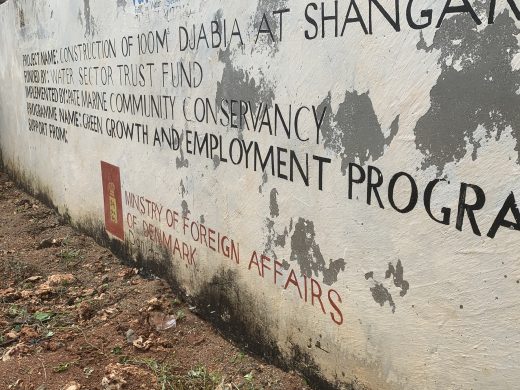Om et par ugers tid mødes forhandlere fra alle verdens lande for at diskutere det udkast til en global klimaaftale, som efter planen skal vedtages i Paris i slutningen af året. Et af de vigtigste værktøjer i den nye aftale er den Grønne Klimafond, som man besluttede at etablere i København i 2009 under det seneste, fejlslagne forsøg på at opnå en global aftale. Fonden, der skal finansiere både reduktions- og tilpasningsprojekter i udviklingslandene, blev efter lang tids tilløb endelig dømt klar til at modtage bidrag sidste efterår forud for klimaforhandlingerne i Lima.
Det officielle mandat er at hjælpe udviklingslandene til at foretage et paradigmeskift til en lav-emissions og modstandsdygtig udviklingsmodel. Nøgleordet her er paradigmeskifte. Det indebærer – eller bør i hvert fald indebære – at fonden kun støtter projekter, der medfører et reelt skifte væk fra enhver praksis, som ikke er forenelig med de klimaudfordringer, vi står over for. Derfor er det også absurd og utroligt skuffende, at fondens bestyrelse har valgt ikke at sætte nogen som helst begrænsninger for hvilke projekter, der kan støttes.
Vi er ellers mange i civilsamfundet, der har argumenteret kraftigt for nødvendigheden af en såkaldt eksklusionsliste. Denne liste skulle bl.a. indeholde kul, olie og gas, men ødelæggende modstand fra bl.a. Japan, Kina og Saudi Arabien fik imidlertid forpurret den ide. Det betyder reelt, at den Grønne Klimafond, en af hjørnestenene i den internationale kamp mod klimaforandringerne, kan finansiere kulkraftværker, hvor man vil afbrænde den mest beskidte form for fossile brændsler.
Fra Japan lød det blandt andet, at nye kulkraftværker er mindre forurenende end gamle og derfor bør kvalificere som ren energi. Det mest chokerende i den sammenhæng er den manglende evne til at anerkende, hvor absurd det er at bruge klimafinansiering på kraftværker, der i meget høj grad bidrager til den globale opvarmning – selvom disse kraftværker så skulle være
Uden klare regler på området betyder det, at beslutningen skal tages fra projekt til projekt. Man kan således stadig håbe på, at fonden i praksis holder sig fra den slags giftige investeringer, der udover at skade klimaet også underminerer fondens integritet fuldstændig. Fonden bør holde sig til projekter, der fremmer vedvarende energi og energieffektivitet og dermed reelt medfører et paradigmeskifte ved at være med til at sikre en grøn og bæredygtig fremtid for udviklingslandene.
Derudover skal fonden støtte tilpasningsprojekter i udviklingslandene, så man her kan modstå de klimakonsekvenser, der er virkelighed nu, men kun bliver værre i fremtiden.
Fonden må stoppe hykleriet og i stedet sætte sig i førersædet for den grønne omstilling som det lokomotiv, der har været ambitionen fra begyndelsen.
Geneva, 12 May 2015 – Up to 90 per cent of the world’s electronic waste, worth nearly US $19 billion, is illegally traded or dumped each year, according to a report released today by the United Nations Environment Programme (UNEP).
Each year, the electronic industry – one of the world’s largest and fastest growing – generates up to 41 million tonnes of e-waste from goods such as computers and smart phones. Forecasts say that figure may reach 50 million tonnes already by 2017.
– See more at: http://www.unep.org/newscentre/Default.aspx?DocumentID=26816&ArticleID=35021&l=en#sthash.K2uxzWrj.dpuf
Geneva, 12 May 2015 – Up to 90 per cent of the world’s electronic waste, worth nearly US $19 billion, is illegally traded or dumped each year, according to a report released today by the United Nations Environment Programme (UNEP).
Each year, the electronic industry – one of the world’s largest and fastest growing – generates up to 41 million tonnes of e-waste from goods such as computers and smart phones. Forecasts say that figure may reach 50 million tonnes already by 2017.
A staggering 60-90 per cent of this waste is illegally traded or dumped, according to UNEP’s “Waste Crimes, Waste Risks: Gaps and Challenges In the Waste Sector”, launched today in Geneva, at the Conference of Parties to the three major conventions addressing the global waste issue, the Basel, Rotterdam and Stockholm Conventions.
The International Criminal Police Organization (INTERPOL) estimates the price of a tonne of e-waste at around US $500. Following this calculation, the value of unregistered and informally handled, including illegally traded and dumped e-waste ranges from US $12.5 to US $18.8 billion annually.
UN Under-Secretary-General and Executive Director of UNEP, Achim Steiner said: “We are witnessing an unprecedented amount of electronic waste rolling out over the world. Not only does it account for a large portion of the world’s non-recycled »waste mountain«, but it also poses a growing threat to human health and the environment, due to the hazardous elements it contains.”
“Through enhanced international cooperation and legislative coherence, stronger national regulations and enforcement, as well as greater awareness and robust prevention measures we can ensure that the illegal trade and dumping of e-waste is brought to an end. This will create a win-win situation, whereby rare and expensive elements are safely recycled and reused, boosting the formal economy, depriving criminals of income and reducing health risks to the public,” he added.
– See more at: http://www.unep.org/newscentre/Default.aspx?DocumentID=26816&ArticleID=35021&l=en#sthash.K2uxzWrj.dpuf
Geneva, 12 May 2015 – Up to 90 per cent of the world’s electronic waste, worth nearly US $19 billion, is illegally traded or dumped each year, according to a report released today by the United Nations Environment Programme (UNEP).
Each year, the electronic industry – one of the world’s largest and fastest growing – generates up to 41 million tonnes of e-waste from goods such as computers and smart phones. Forecasts say that figure may reach 50 million tonnes already by 2017.
A staggering 60-90 per cent of this waste is illegally traded or dumped, according to UNEP’s “Waste Crimes, Waste Risks: Gaps and Challenges In the Waste Sector”, launched today in Geneva, at the Conference of Parties to the three major conventions addressing the global waste issue, the Basel, Rotterdam and Stockholm Conventions.
The International Criminal Police Organization (INTERPOL) estimates the price of a tonne of e-waste at around US $500. Following this calculation, the value of unregistered and informally handled, including illegally traded and dumped e-waste ranges from US $12.5 to US $18.8 billion annually.
UN Under-Secretary-General and Executive Director of UNEP, Achim Steiner said: “We are witnessing an unprecedented amount of electronic waste rolling out over the world. Not only does it account for a large portion of the world’s non-recycled »waste mountain«, but it also poses a growing threat to human health and the environment, due to the hazardous elements it contains.”
“Through enhanced international cooperation and legislative coherence, stronger national regulations and enforcement, as well as greater awareness and robust prevention measures we can ensure that the illegal trade and dumping of e-waste is brought to an end. This will create a win-win situation, whereby rare and expensive elements are safely recycled and reused, boosting the formal economy, depriving criminals of income and reducing health risks to the public,” he added.
– See more at: http://www.unep.org/newscentre/Default.aspx?DocumentID=26816&ArticleID=35021&l=en#sthash.K2uxzWrj.dpuf
Geneva, 12 May 2015 – Up to 90 per cent of the world’s electronic waste, worth nearly US $19 billion, is illegally traded or dumped each year, according to a report released today by the United Nations Environment Programme (UNEP).
Each year, the electronic industry – one of the world’s largest and fastest growing – generates up to 41 million tonnes of e-waste from goods such as computers and smart phones. Forecasts say that figure may reach 50 million tonnes already by 2017.
A staggering 60-90 per cent of this waste is illegally traded or dumped, according to UNEP’s “Waste Crimes, Waste Risks: Gaps and Challenges In the Waste Sector”, launched today in Geneva, at the Conference of Parties to the three major conventions addressing the global waste issue, the Basel, Rotterdam and Stockholm Conventions.
The International Criminal Police Organization (INTERPOL) estimates the price of a tonne of e-waste at around US $500. Following this calculation, the value of unregistered and informally handled, including illegally traded and dumped e-waste ranges from US $12.5 to US $18.8 billion annually.
UN Under-Secretary-General and Executive Director of UNEP, Achim Steiner said: “We are witnessing an unprecedented amount of electronic waste rolling out over the world. Not only does it account for a large portion of the world’s non-recycled »waste mountain«, but it also poses a growing threat to human health and the environment, due to the hazardous elements it contains.”
“Through enhanced international cooperation and legislative coherence, stronger national regulations and enforcement, as well as greater awareness and robust prevention measures we can ensure that the illegal trade and dumping of e-waste is brought to an end. This will create a win-win situation, whereby rare and expensive elements are safely recycled and reused, boosting the formal economy, depriving criminals of income and reducing health risks to the public,” he added.
– See more at: http://www.unep.org/newscentre/Default.aspx?DocumentID=26816&ArticleID=35021&l=en#sthash.K2uxzWrj.dpuf
Geneva, 12 May 2015 – Up to 90 per cent of the world’s electronic waste, worth nearly US $19 billion, is illegally traded or dumped each year, according to a report released today by the United Nations Environment Programme (UNEP).
Each year, the electronic industry – one of the world’s largest and fastest growing – generates up to 41 million tonnes of e-waste from goods such as computers and smart phones. Forecasts say that figure may reach 50 million tonnes already by 2017.
A staggering 60-90 per cent of this waste is illegally traded or dumped, according to UNEP’s “Waste Crimes, Waste Risks: Gaps and Challenges In the Waste Sector”, launched today in Geneva, at the Conference of Parties to the three major conventions addressing the global waste issue, the Basel, Rotterdam and Stockholm Conventions.
The International Criminal Police Organization (INTERPOL) estimates the price of a tonne of e-waste at around US $500. Following this calculation, the value of unregistered and informally handled, including illegally traded and dumped e-waste ranges from US $12.5 to US $18.8 billion annually.
UN Under-Secretary-General and Executive Director of UNEP, Achim Steiner said: “We are witnessing an unprecedented amount of electronic waste rolling out over the world. Not only does it account for a large portion of the world’s non-recycled »waste mountain«, but it also poses a growing threat to human health and the environment, due to the hazardous elements it contains.”
“Through enhanced international cooperation and legislative coherence, stronger national regulations and enforcement, as well as greater awareness and robust prevention measures we can ensure that the illegal trade and dumping of e-waste is brought to an end. This will create a win-win situation, whereby rare and expensive elements are safely recycled and reused, boosting the formal economy, depriving criminals of income and reducing health risks to the public,” he added.
– See more at: http://www.unep.org/newscentre/Default.aspx?DocumentID=26816&ArticleID=35021&l=en#sthash.K2uxzWrj.dpuf














